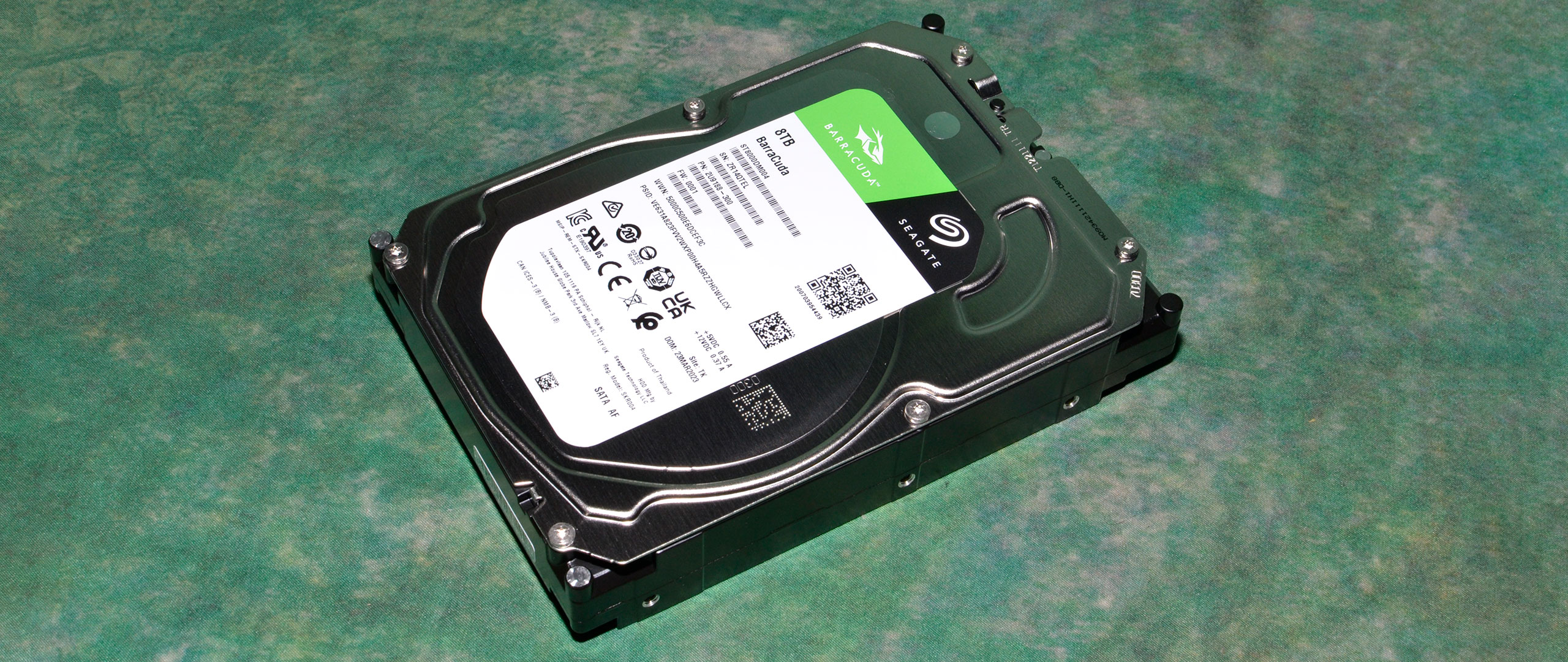Why you can trust Tom's Hardware
Comparison Products
We compared the 8TB Seagate BarraCuda HDD to other 8TB hard drives, including the 8TB WD Blue, the older HGST UltraStar He8, the Seagate IronWolf Pro 8TB, and the Seagate FireCuda. Larger 20TB drives in our test pool include the WD Red Pro, the Seagate Exos X20, the Seagate IronWolf Pro, and the Seagate SkyHawk AI. We also threw in the 14TB Seagate IronWolf Pro and 12TB WD Red Plus.
Trace Testing - 3DMark Storage Benchmark
Yes, gaming isn't the preferred use case for this class of hard drives, but we include these tests for perspective. Built for gamers, 3DMark’s Storage Benchmark focuses on real-world gaming performance. Each round in this benchmark stresses storage based on gaming activities, including loading games, saving progress, installing game files, and recording gameplay video streams.
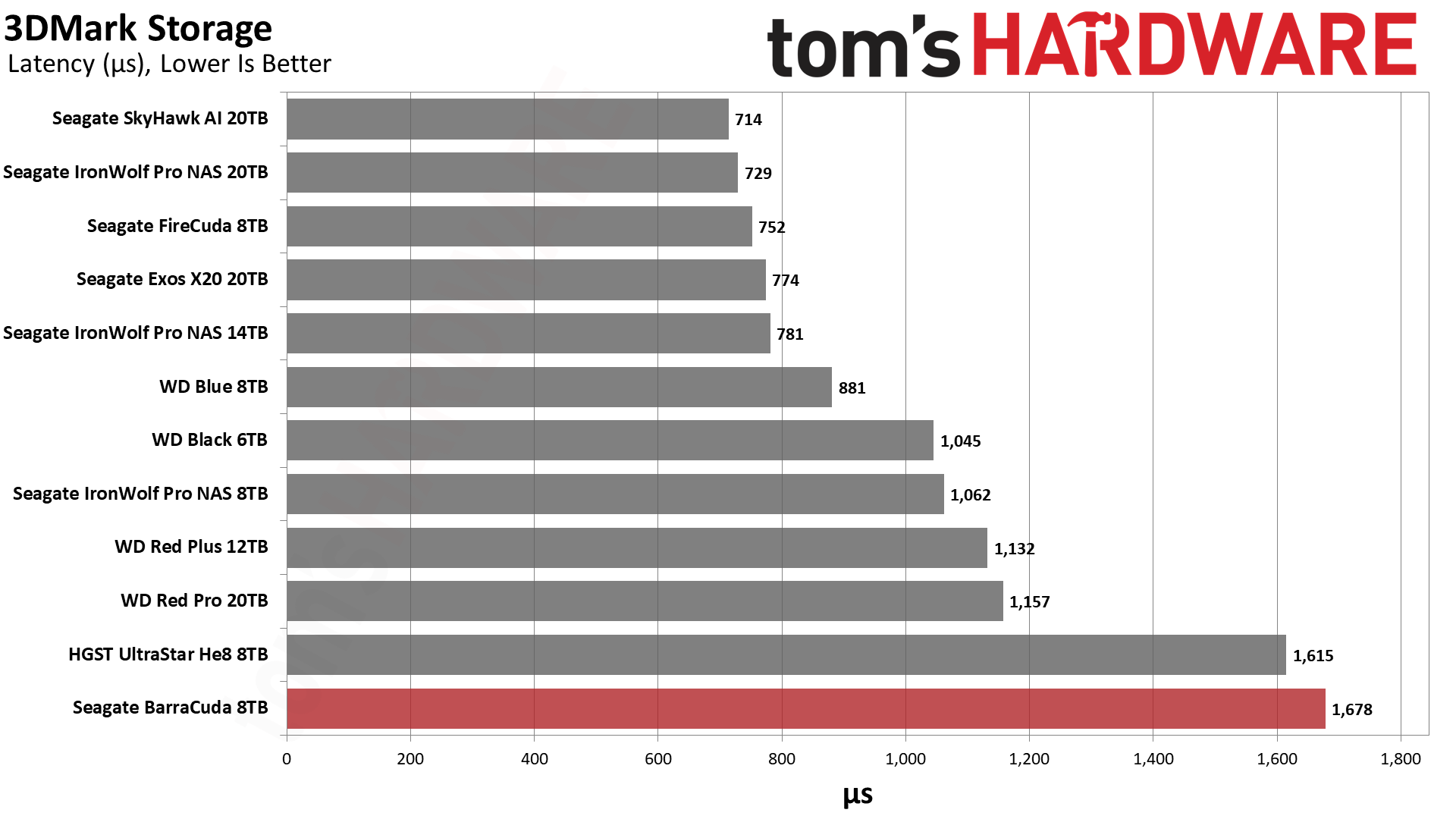
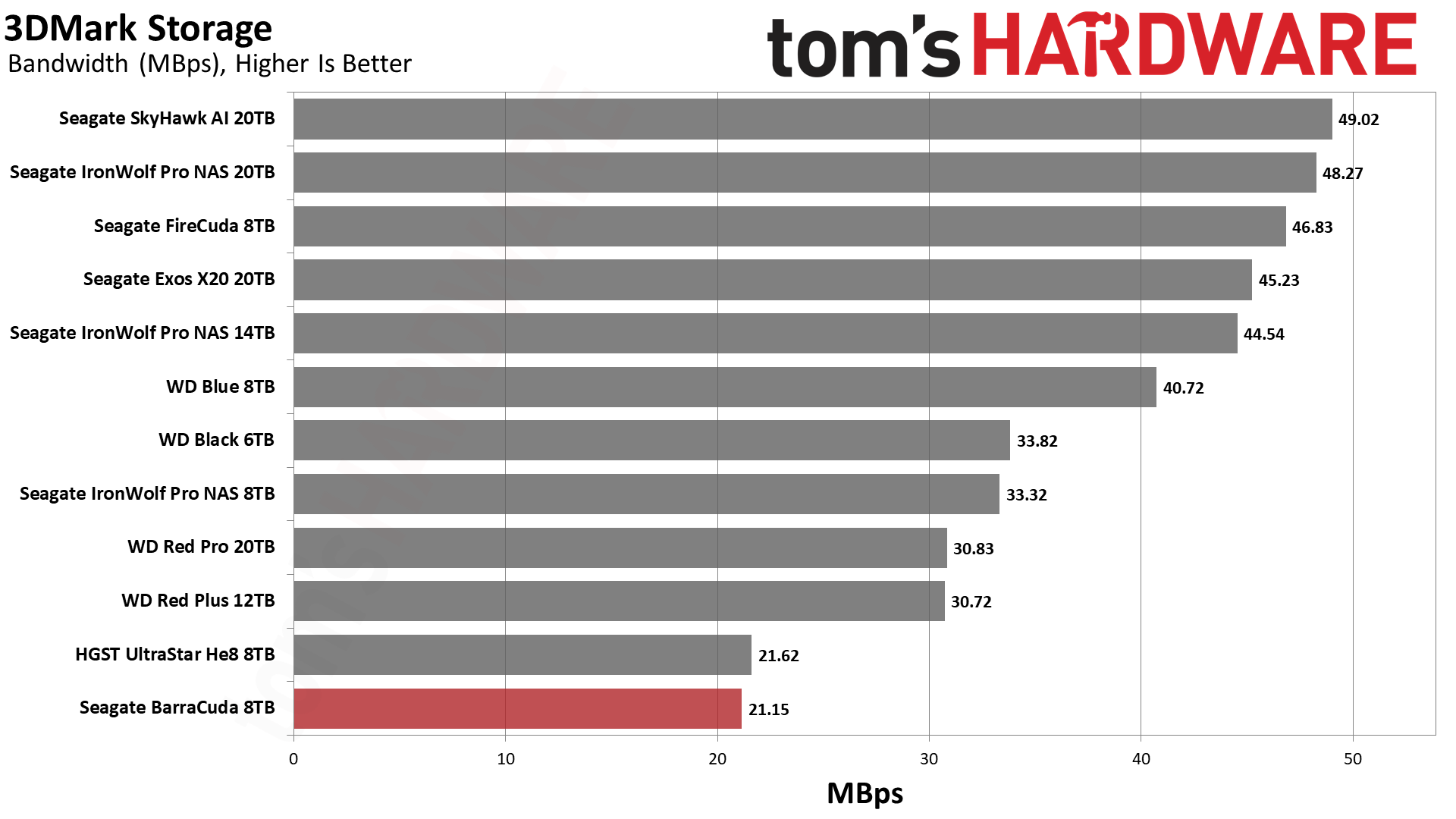
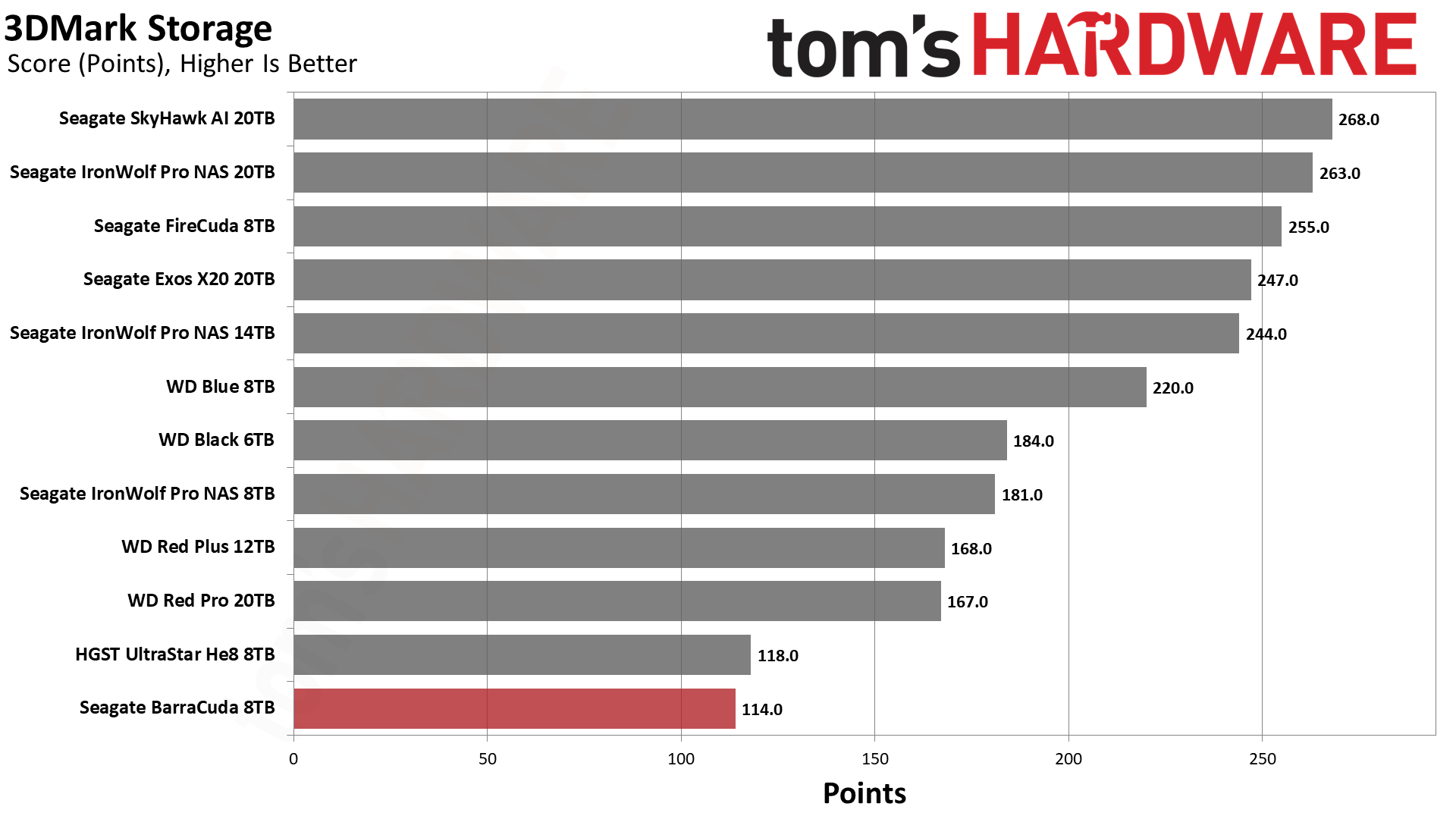
The Seagate BarraCuda ended up dead last in all of 3DMark’s tests, which isn't surprising given its use of SMR technology that reduces performance in variable workloads, such as writing small files or random data writes interspersed with sequential access. This punishes both throughput and latency.
Trace Testing – PCMark 10 Storage Benchmark
PCMark 10 is a trace-based benchmark that uses a wide-ranging set of real-world traces from popular applications and everyday tasks to measure the performance of storage devices.
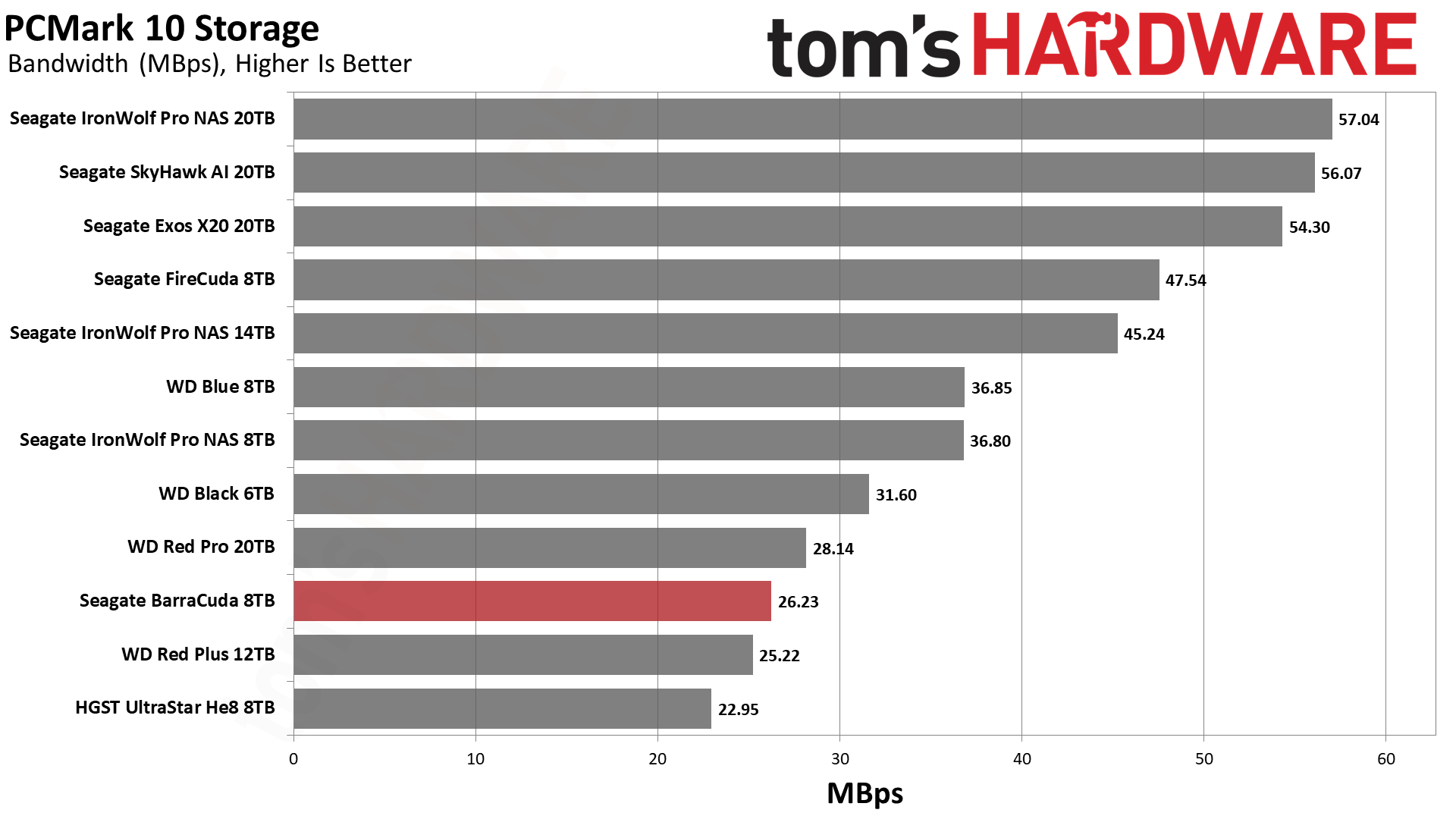
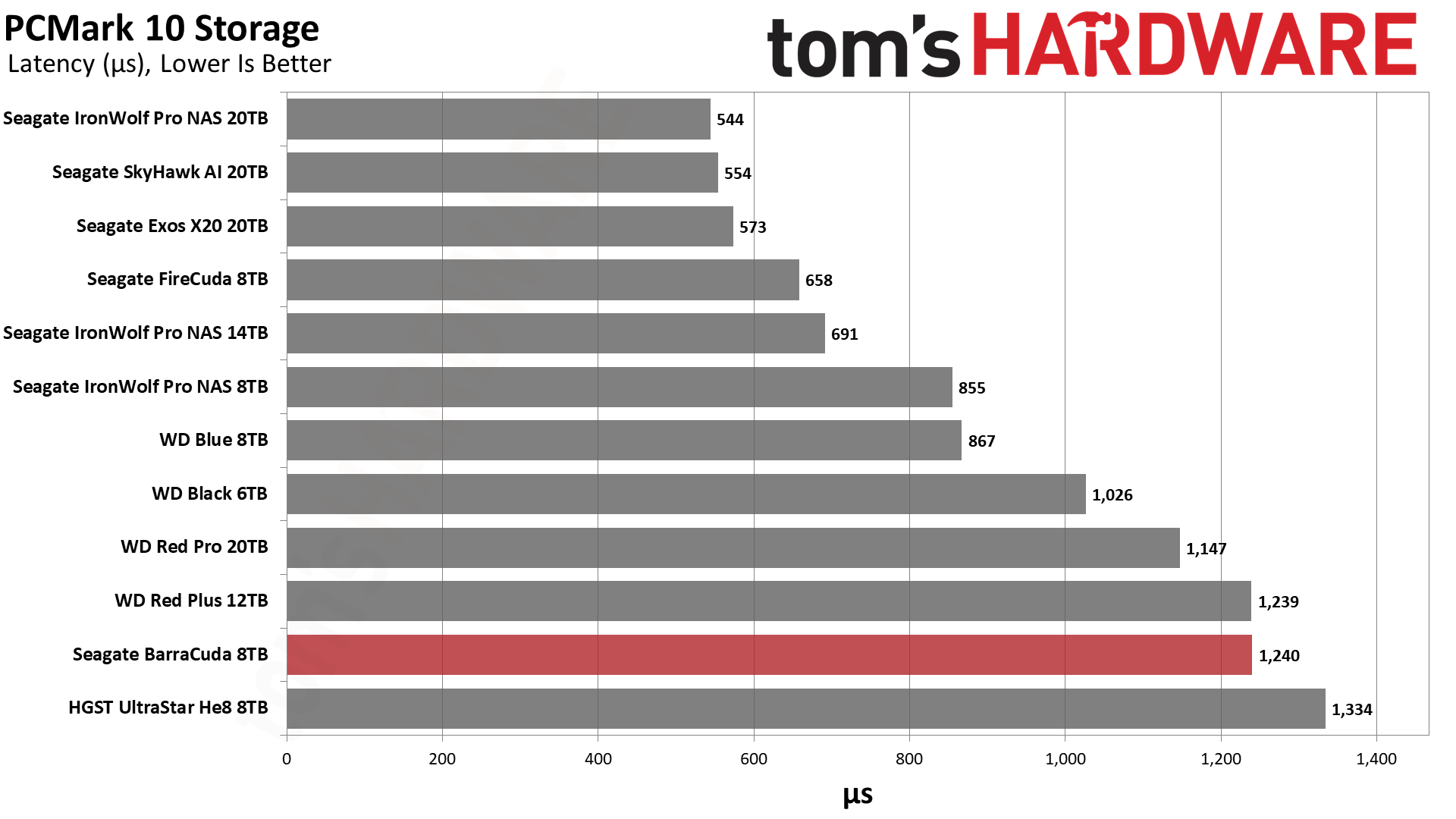
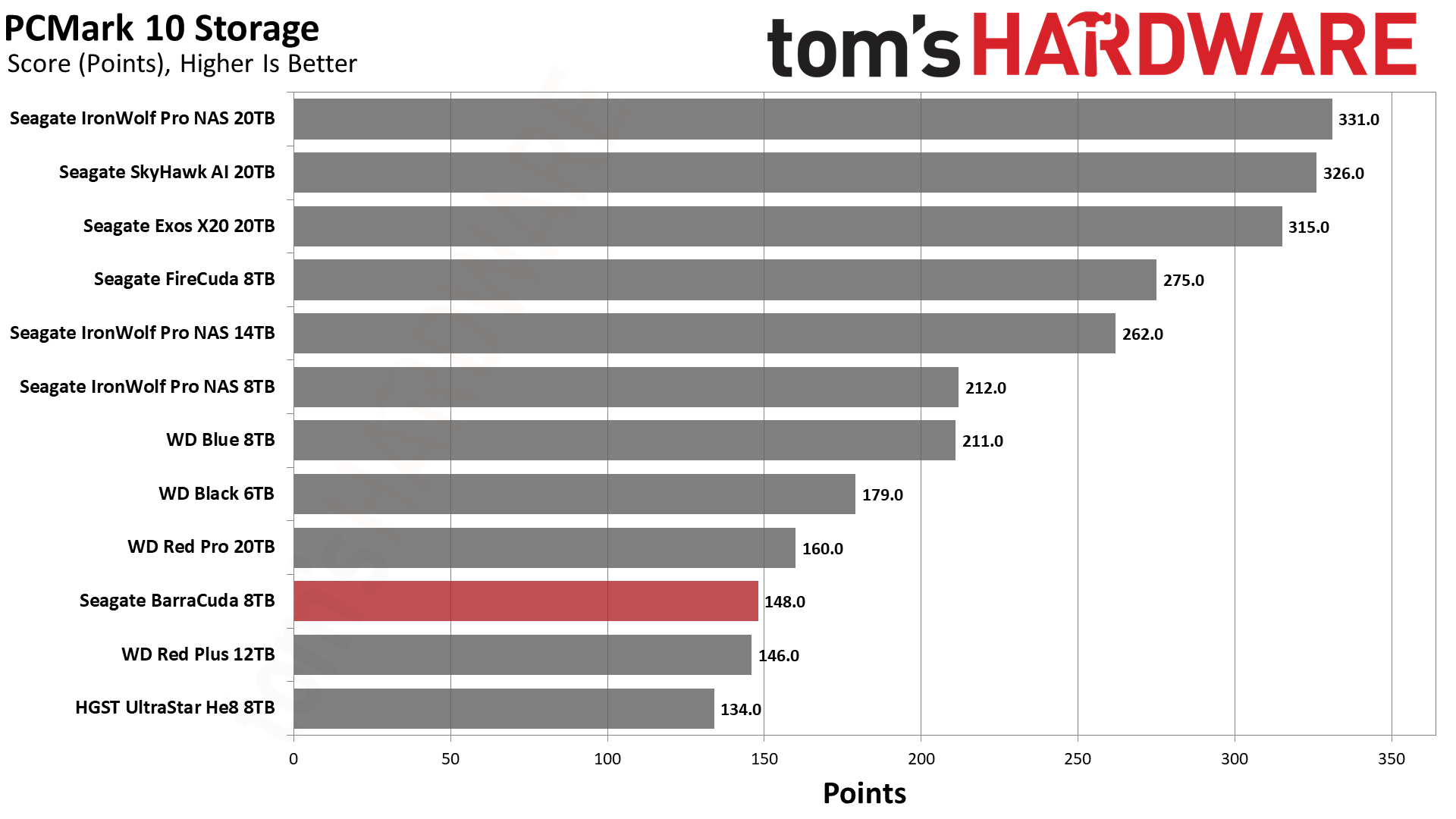
The BarraCuda improves a small amount in PCMark 10, beating the He8 and Red Plus overall, but it’s close to the latter in performance. More importantly, it trails the competing 8TB WD Blue by large margins, especially given that these two drives come with similar price tags.
Transfer Rates – DiskBench
We use the DiskBench storage benchmarking tool to test file transfer performance with a custom, 50GB dataset. We copy 31,227 files of various types, such as pictures, PDFs, and videos to a new folder and then follow-up with a reading test of a newly-written 6.5GB zip file.
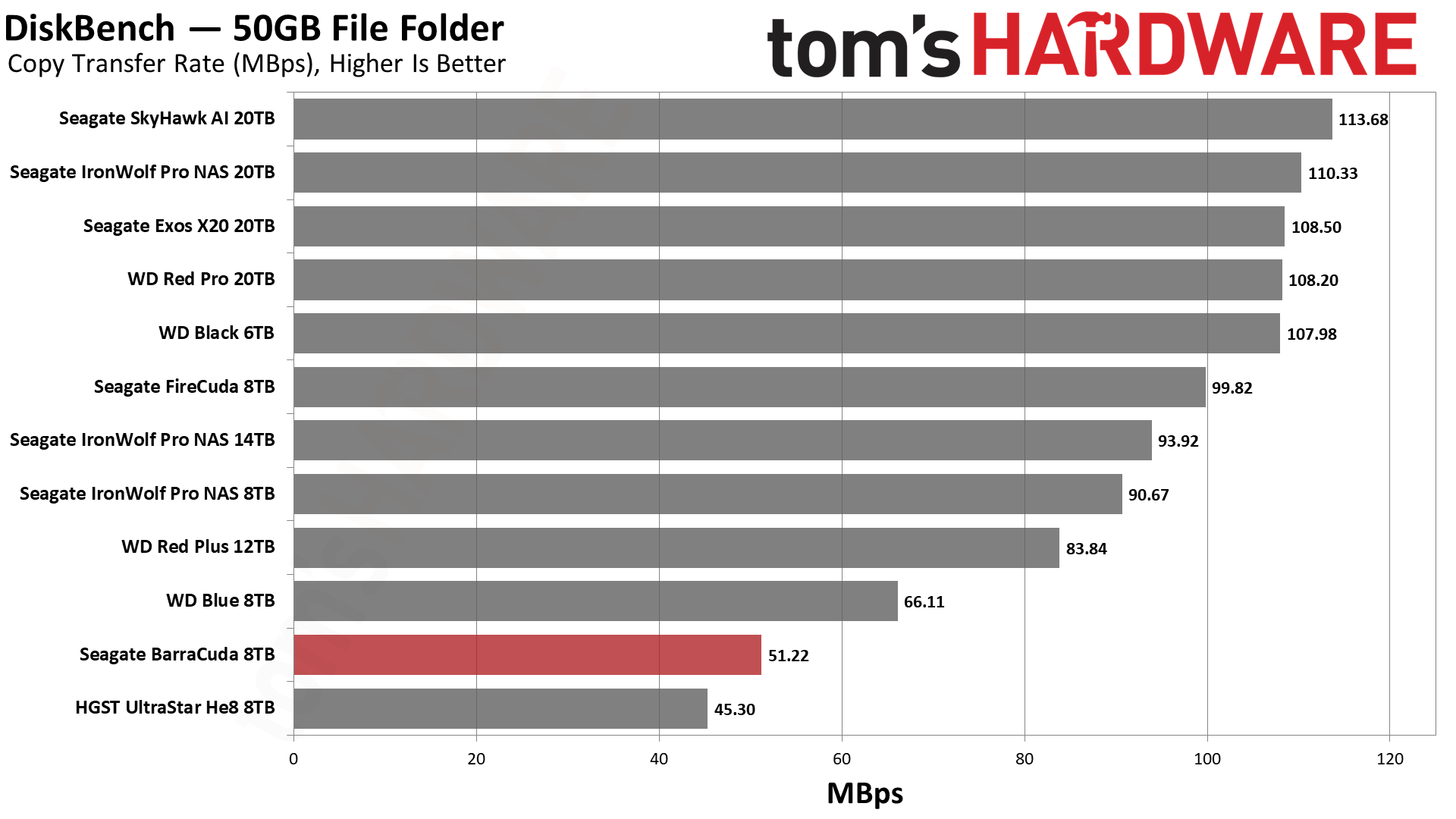
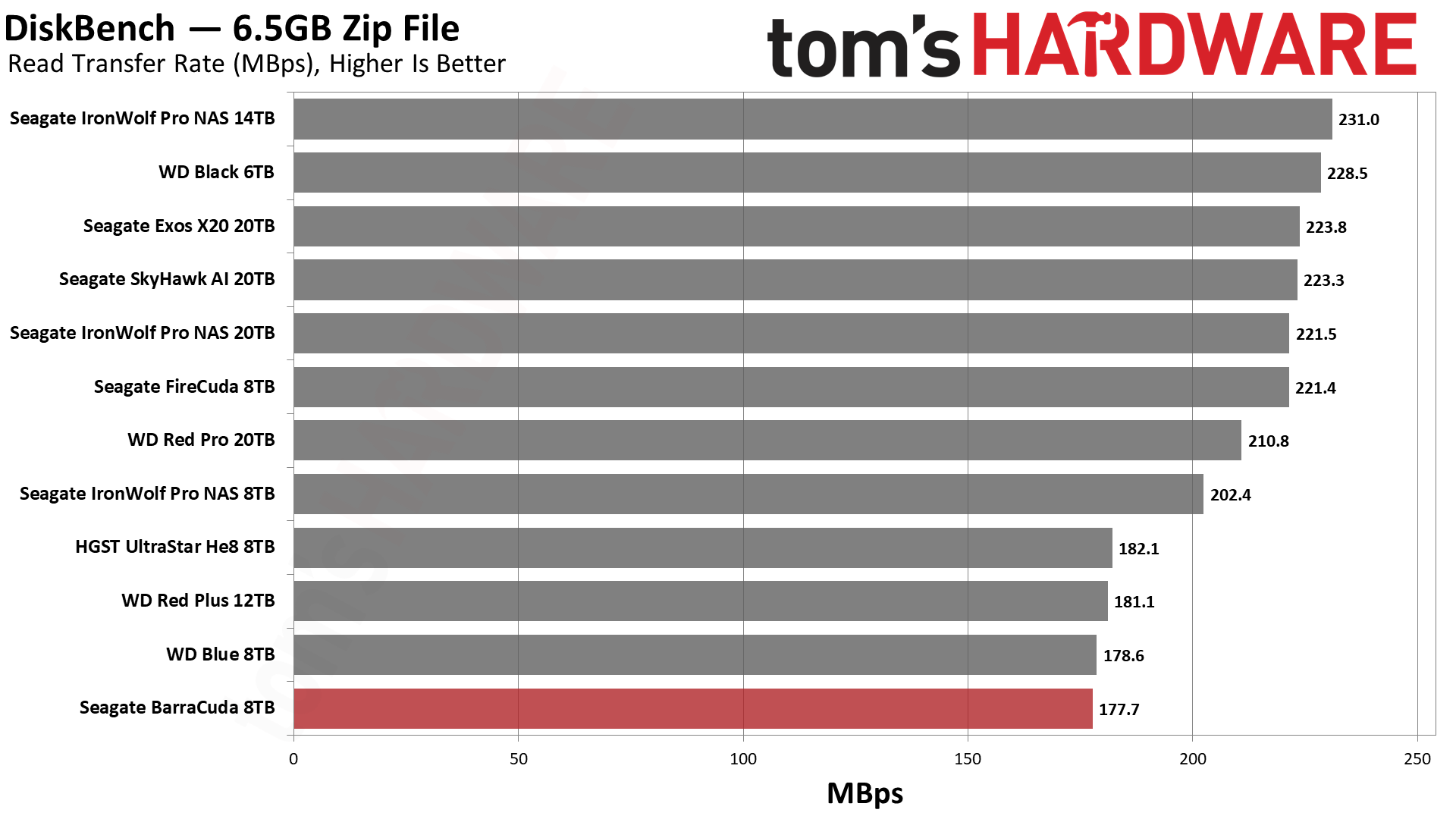
The BarraCuda copies very slowly, even compared to the Blue, so you should only use this drive if you don't have a write-heavy use case. As you can see, write workloads are far more impacted than reading back the data.
Get Tom's Hardware's best news and in-depth reviews, straight to your inbox.
Synthetic Testing - ATTO / CrystalDiskMark
ATTO and CrystalDiskMark (CDM) are free and easy-to-use storage benchmarking tools that storage vendors commonly use to assign performance specifications to their products. Both of these tools give us insight into how each device handles different file sizes.
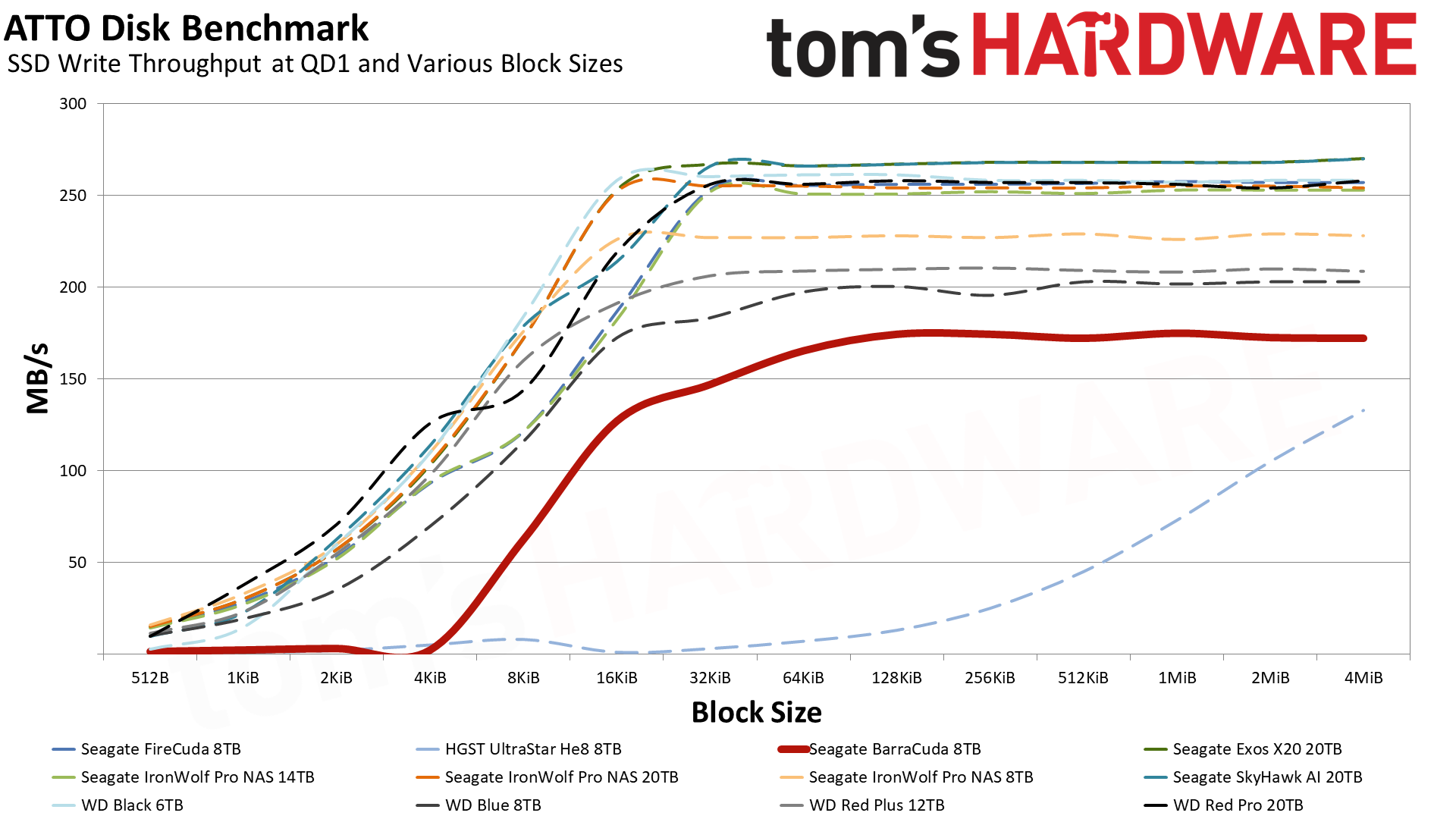
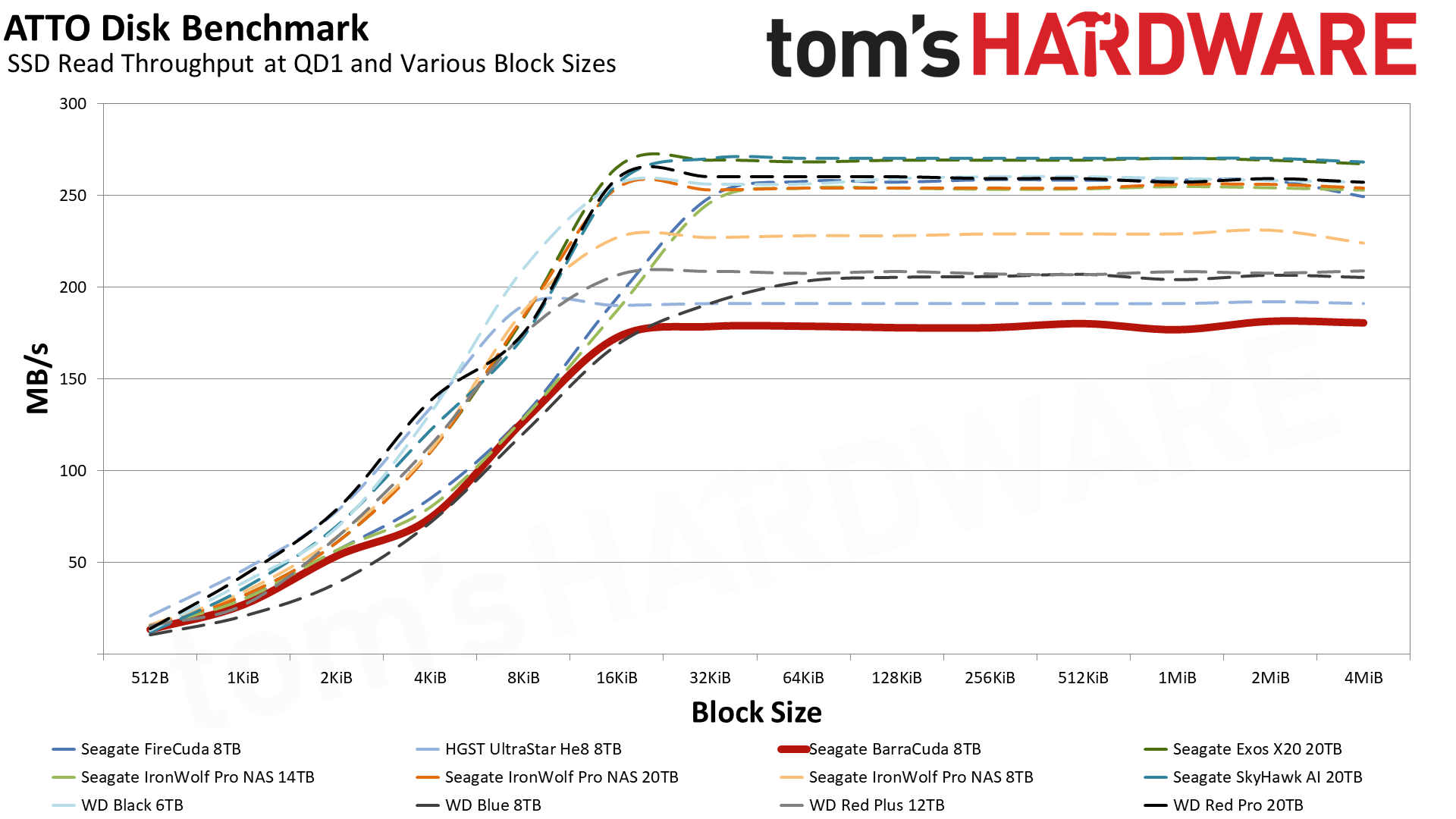
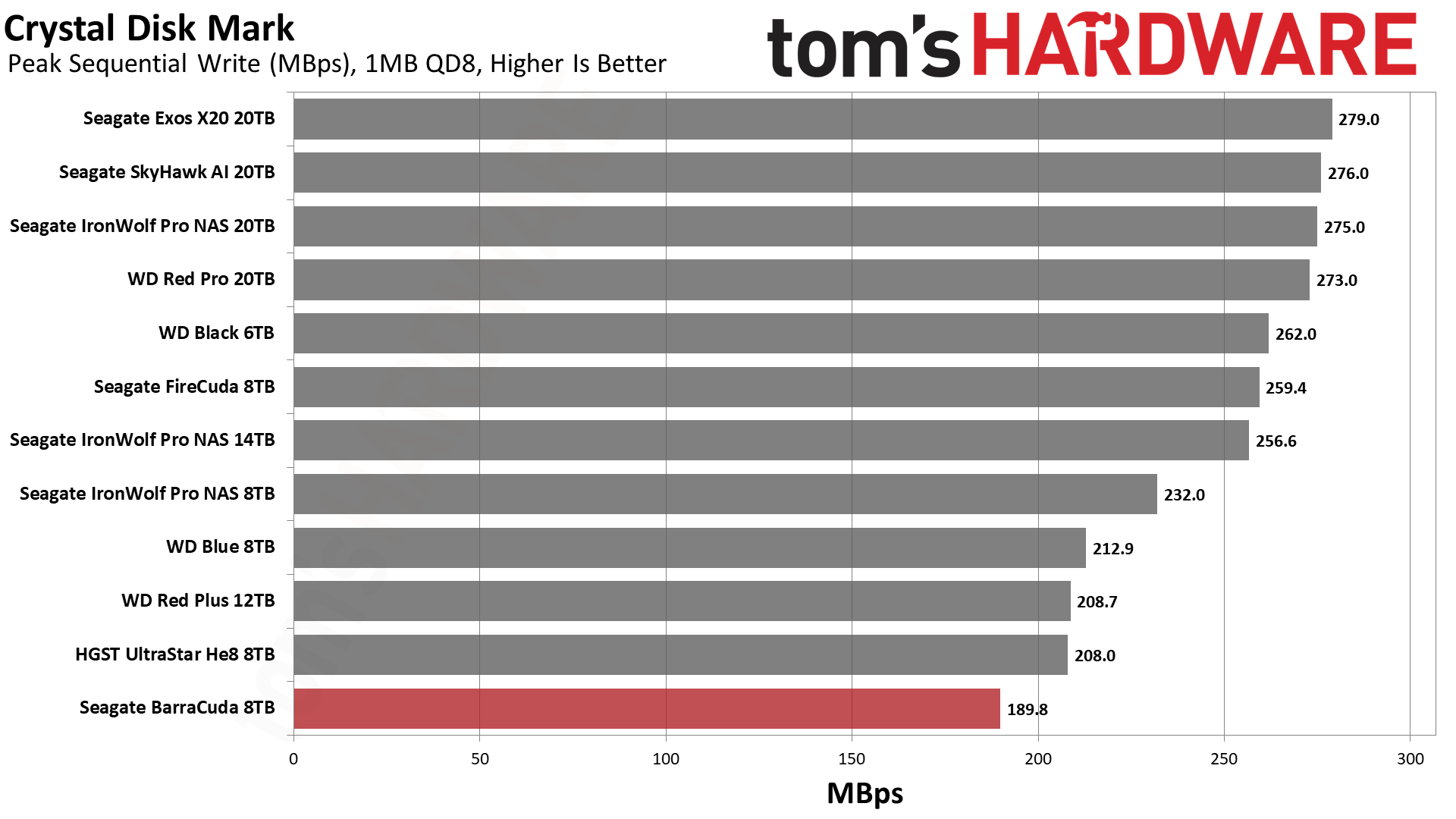
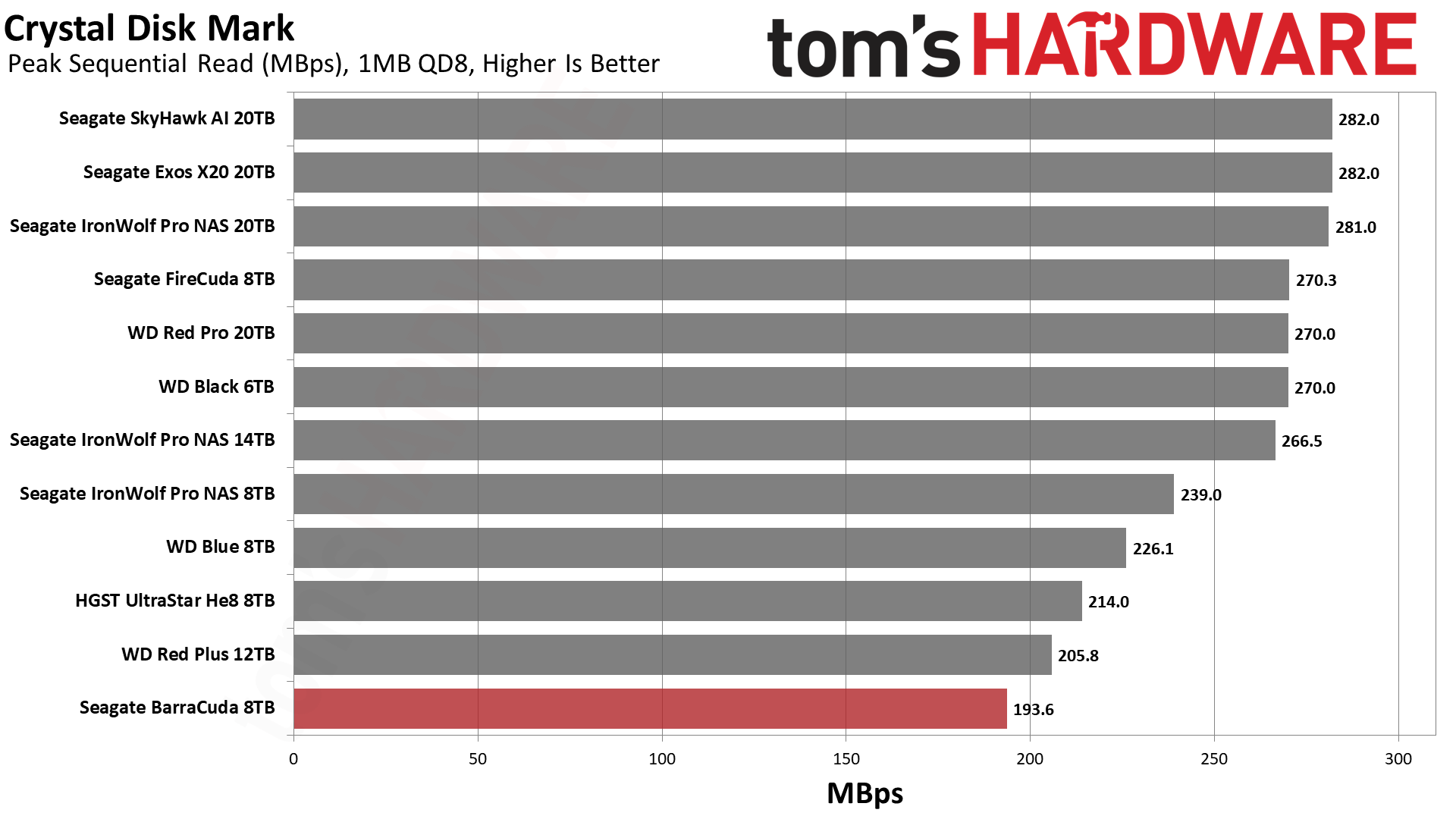
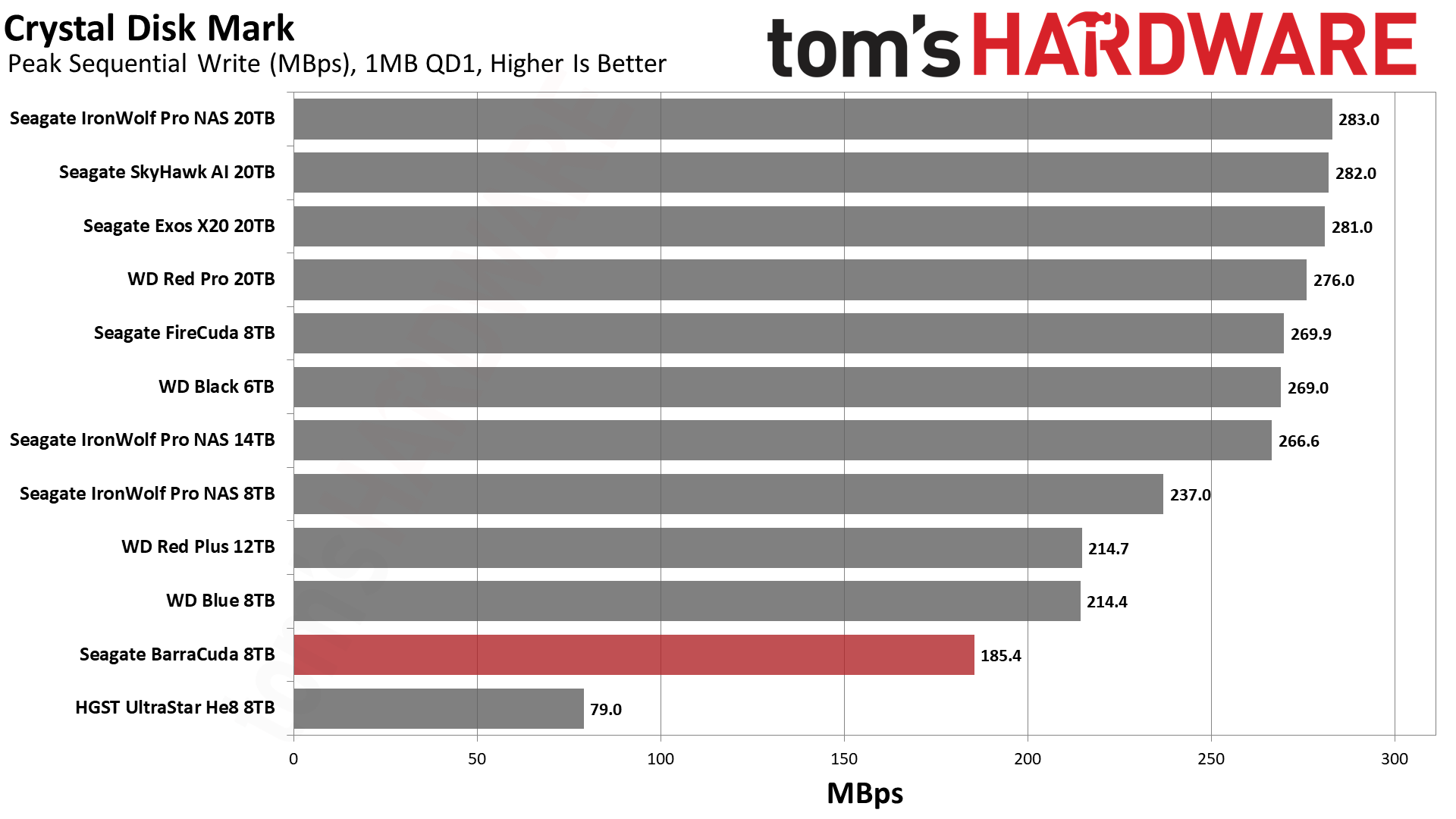
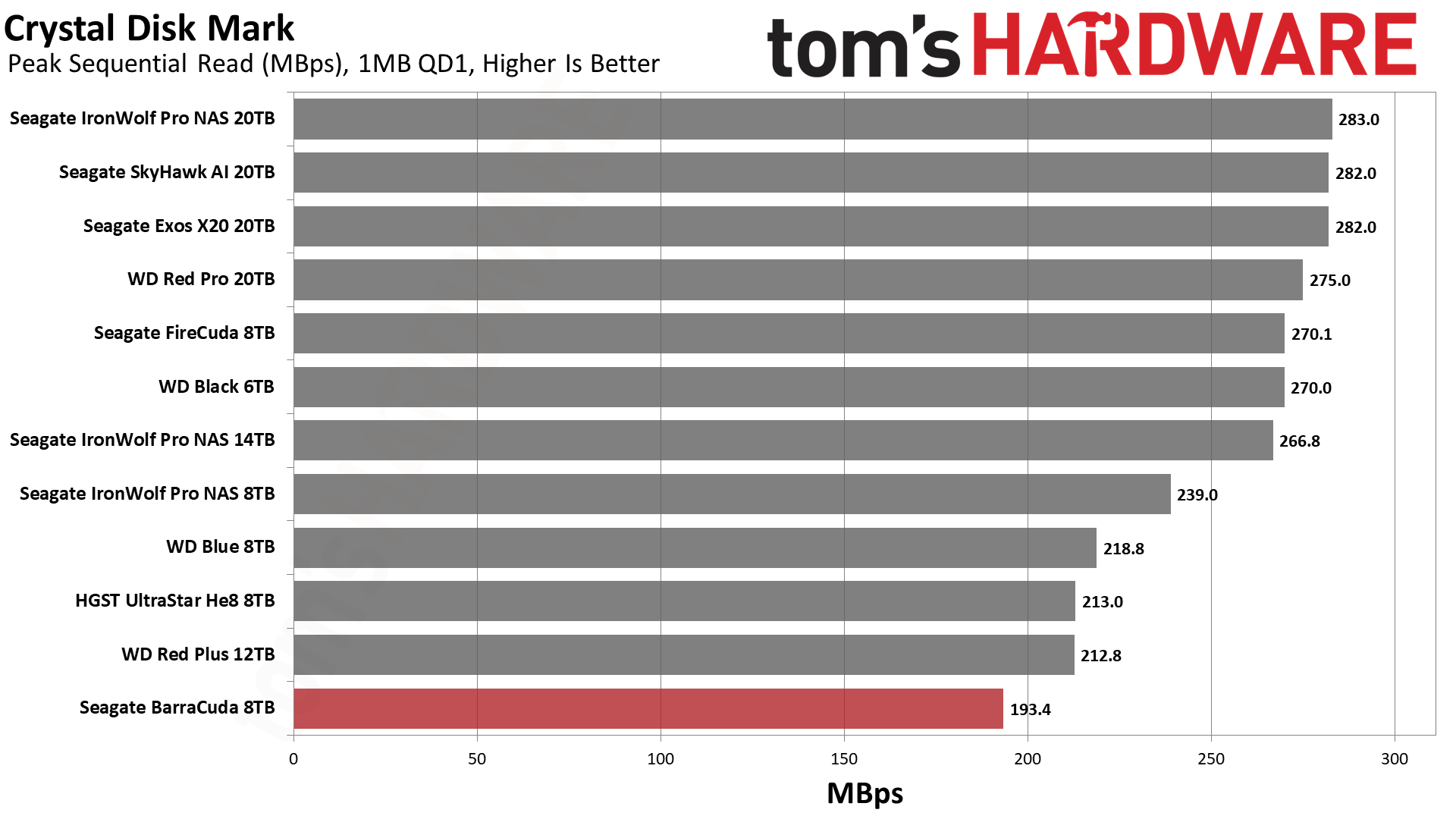
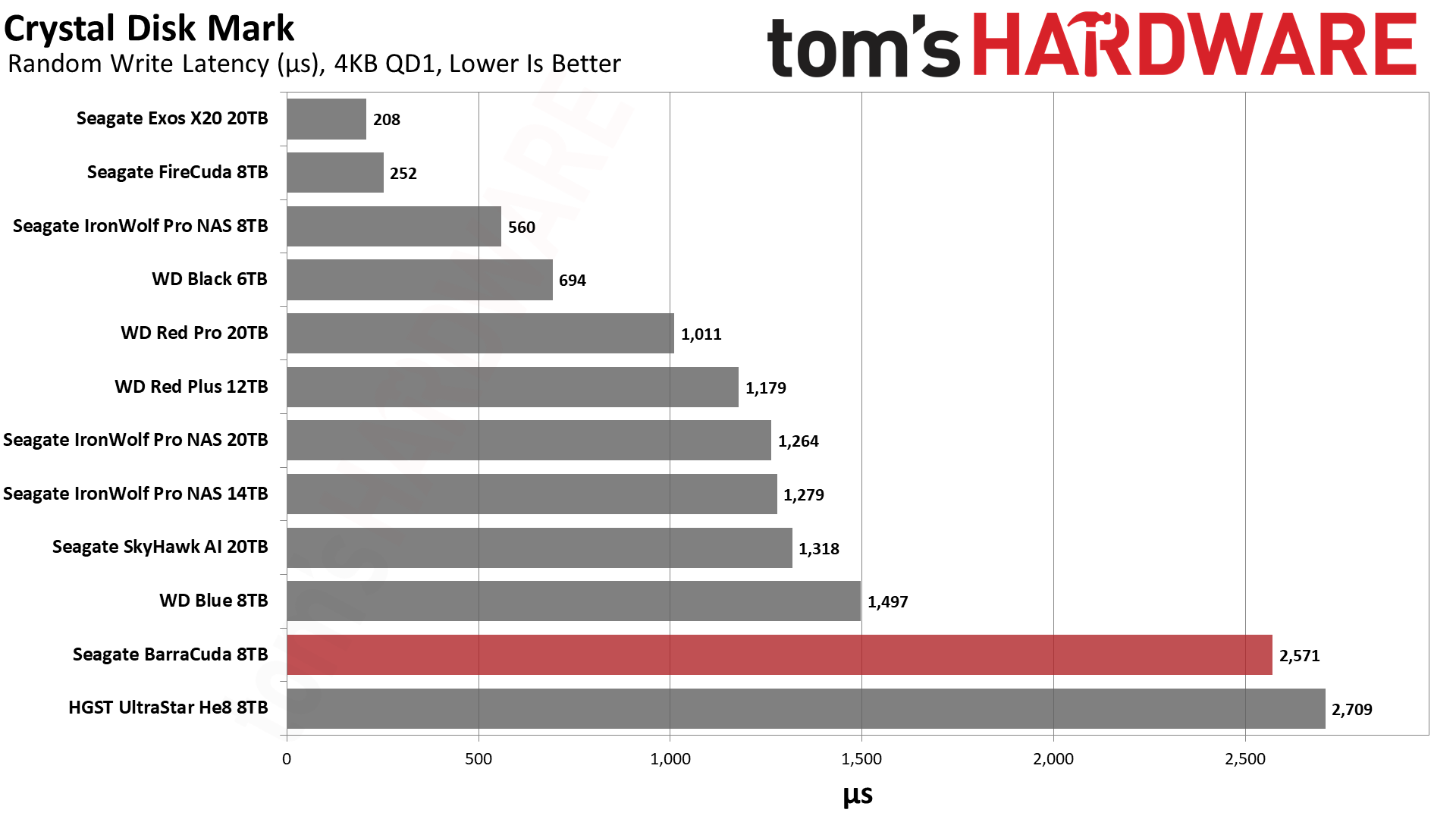
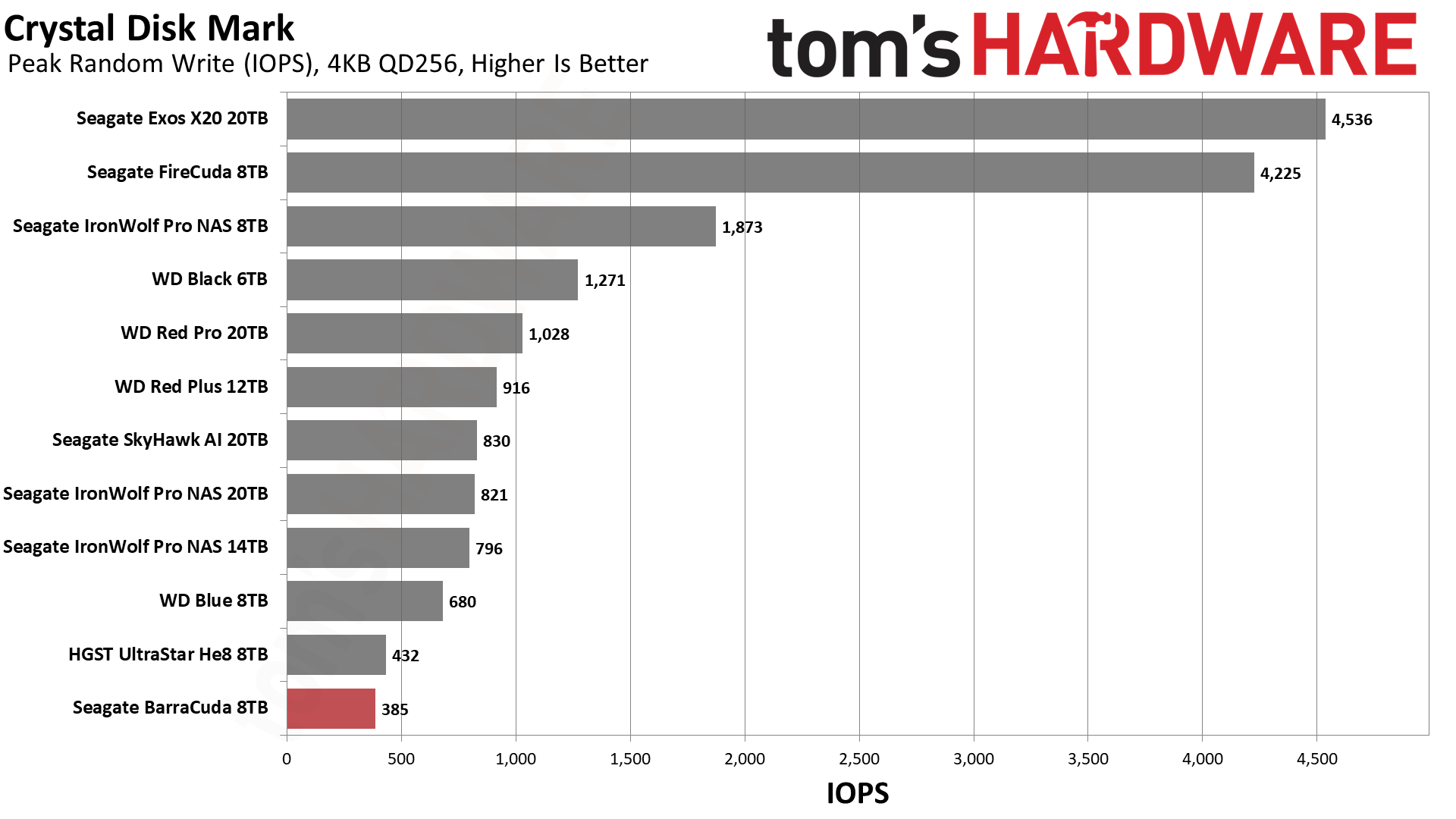
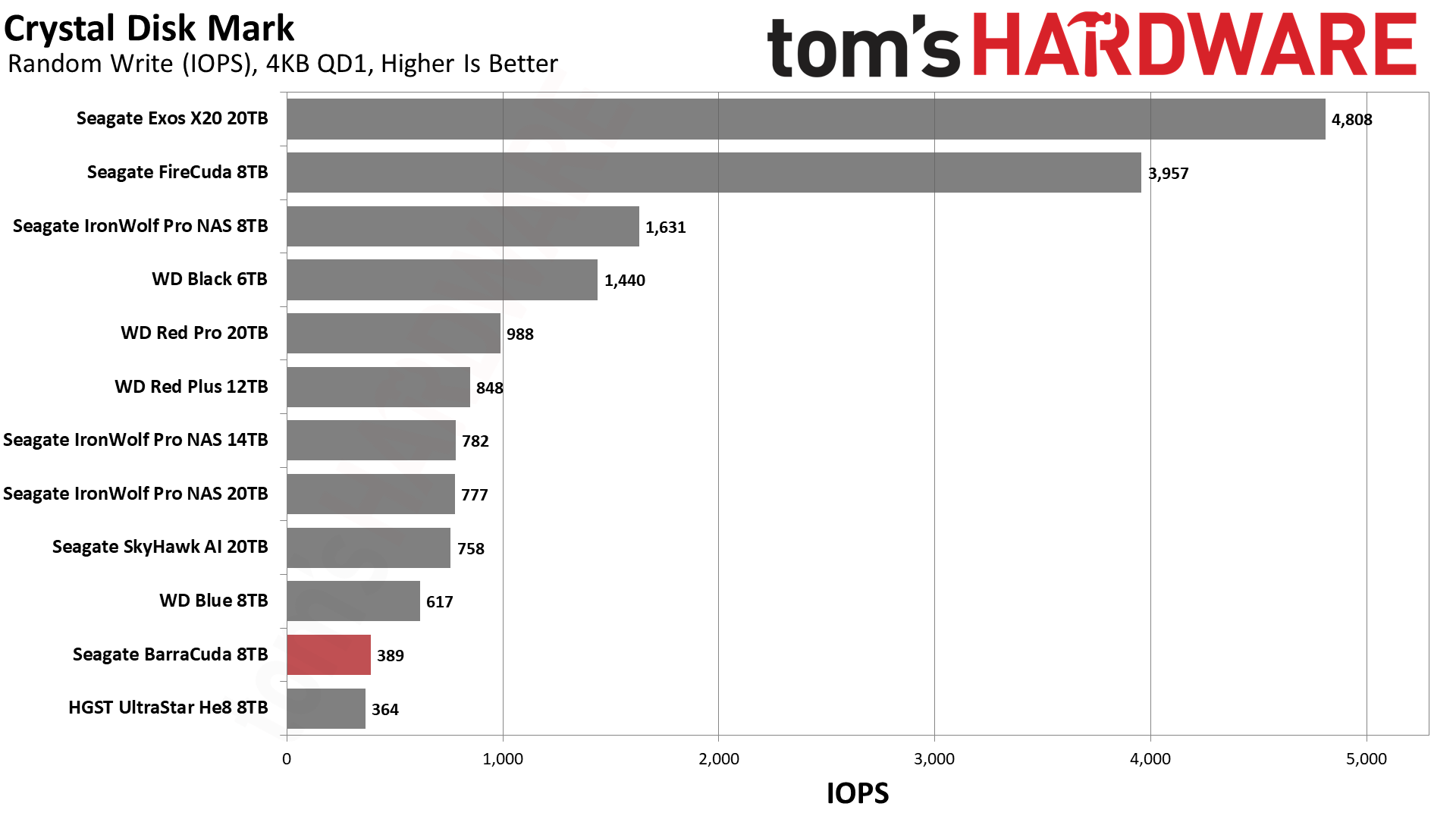
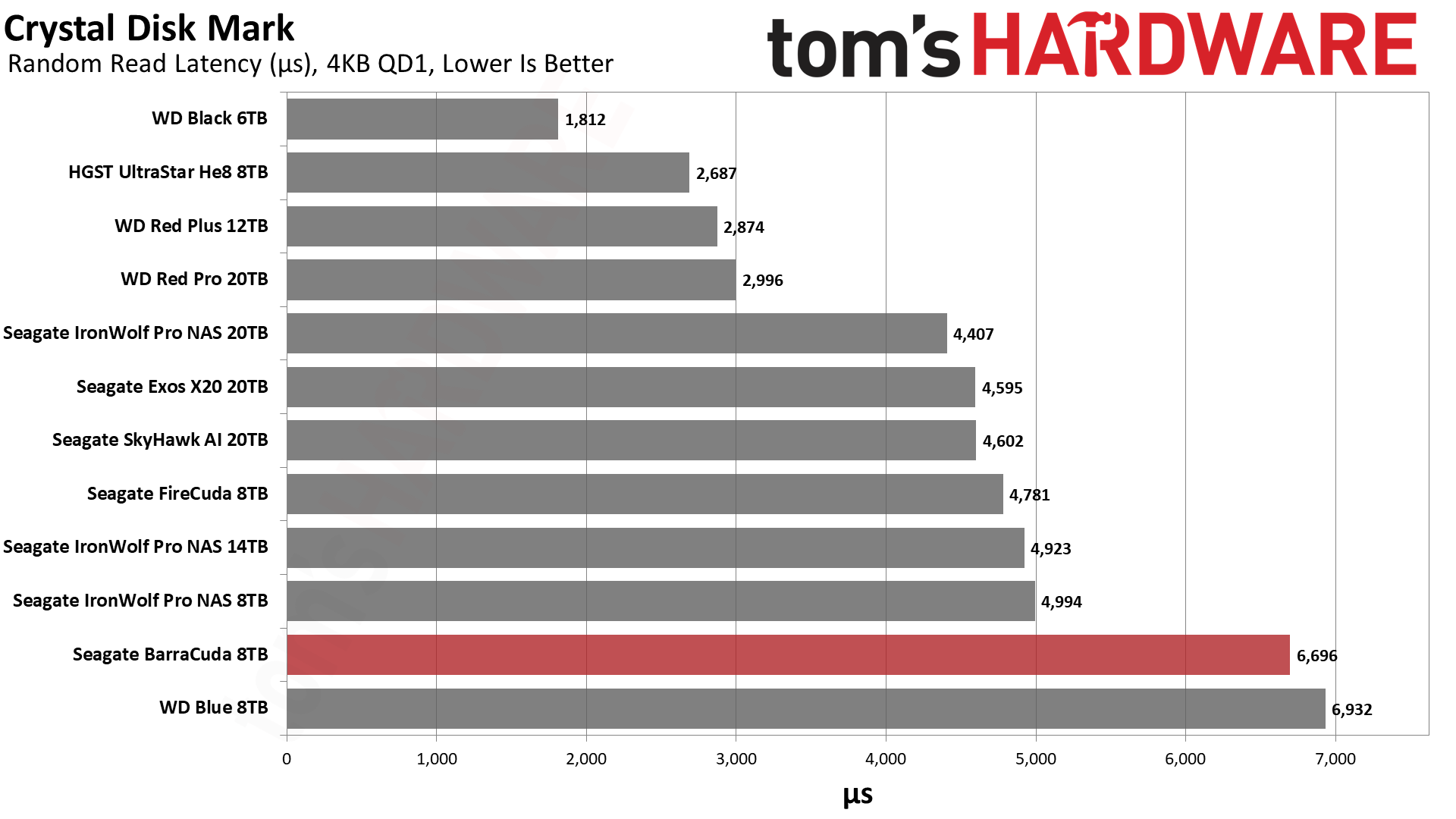
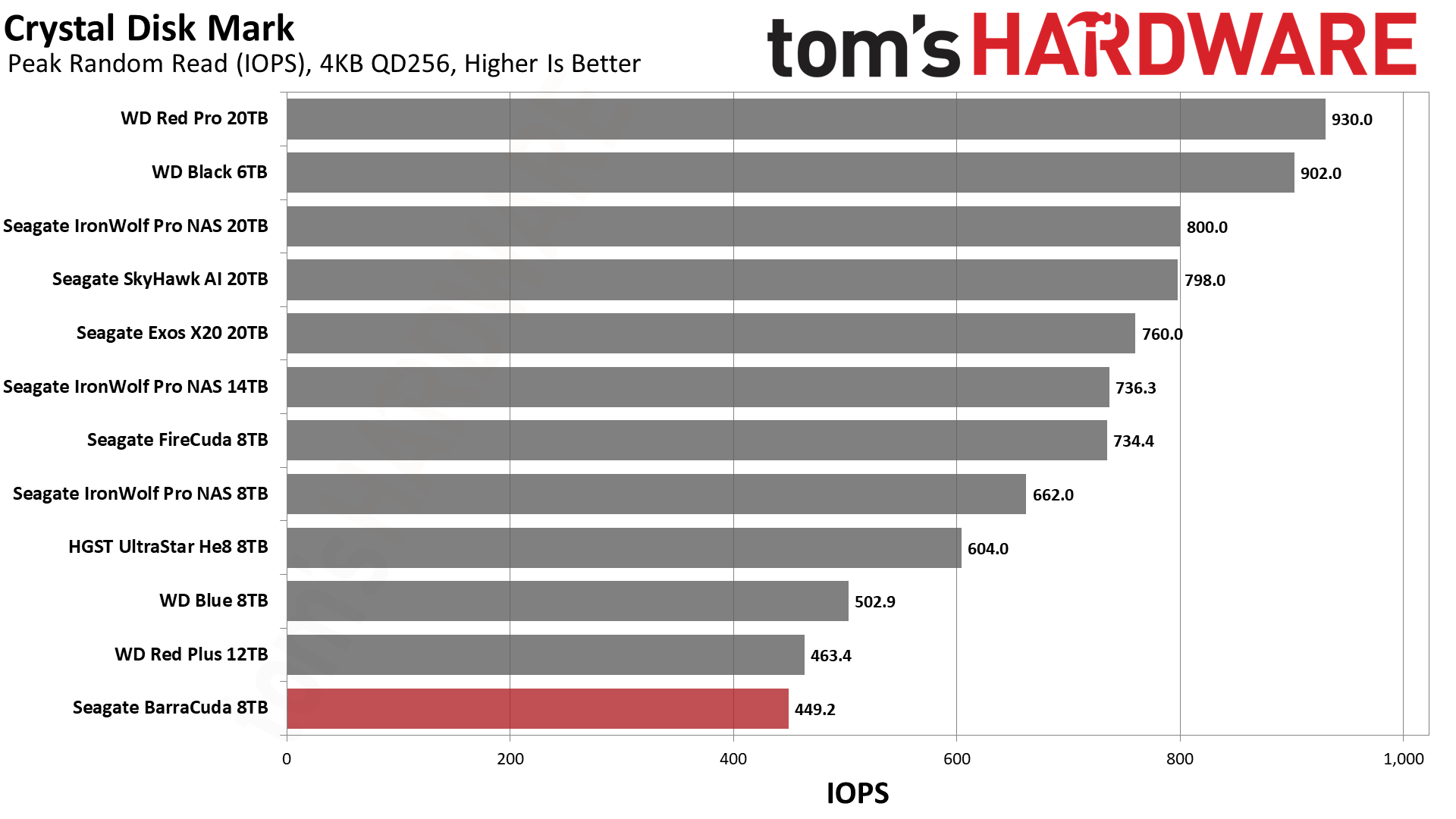

The Seagate BarraCuda’s read performance in ATTO is acceptable, even if it peaks lower than the WD Blue. The BarraCuda's write performance suffers at the hands of its SMR technology. The drive lags the WD Blue even with larger blocks, but it is especially bad at writing smaller block sizes. As such, this drive would best be used to write and store larger files and backups, and the tradeoffs of selecting an SMR drive are clear in these tests.
Sustained Write Performance
Official write specifications are only part of the performance picture. Most HDDs implement a write cache which is a fast area of volatile memory such as DRAM. Sustained write speeds directly hit the platters and tend to be consistent. There are exceptions to both of these statements, as there are SSHDs (flash-containing hybrid HDDs), OptiNAND drives, and SMR drives that deviate from the traditional configuration. We use Iometer to detect the maximum sustained write speed of the HDD.
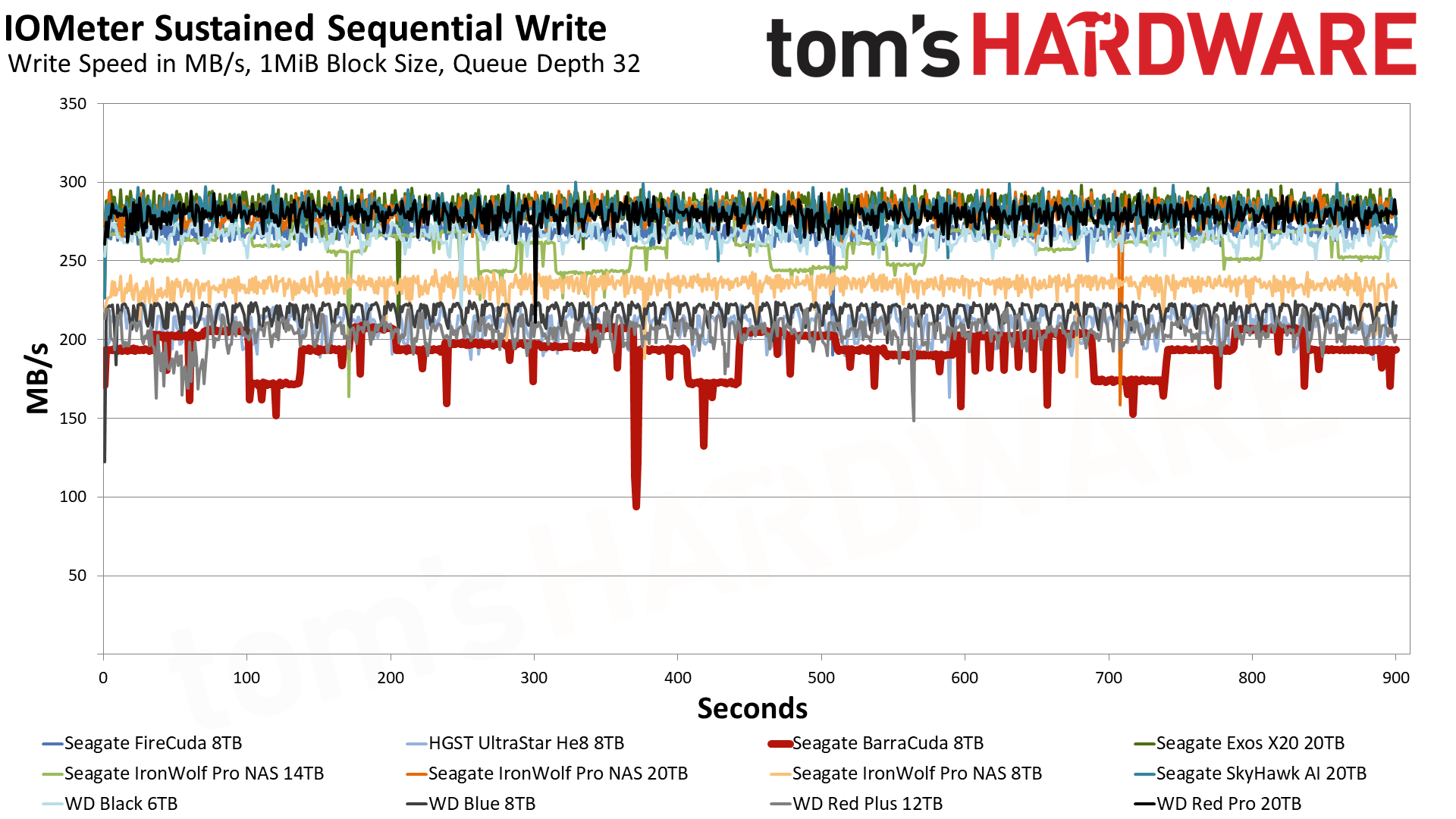
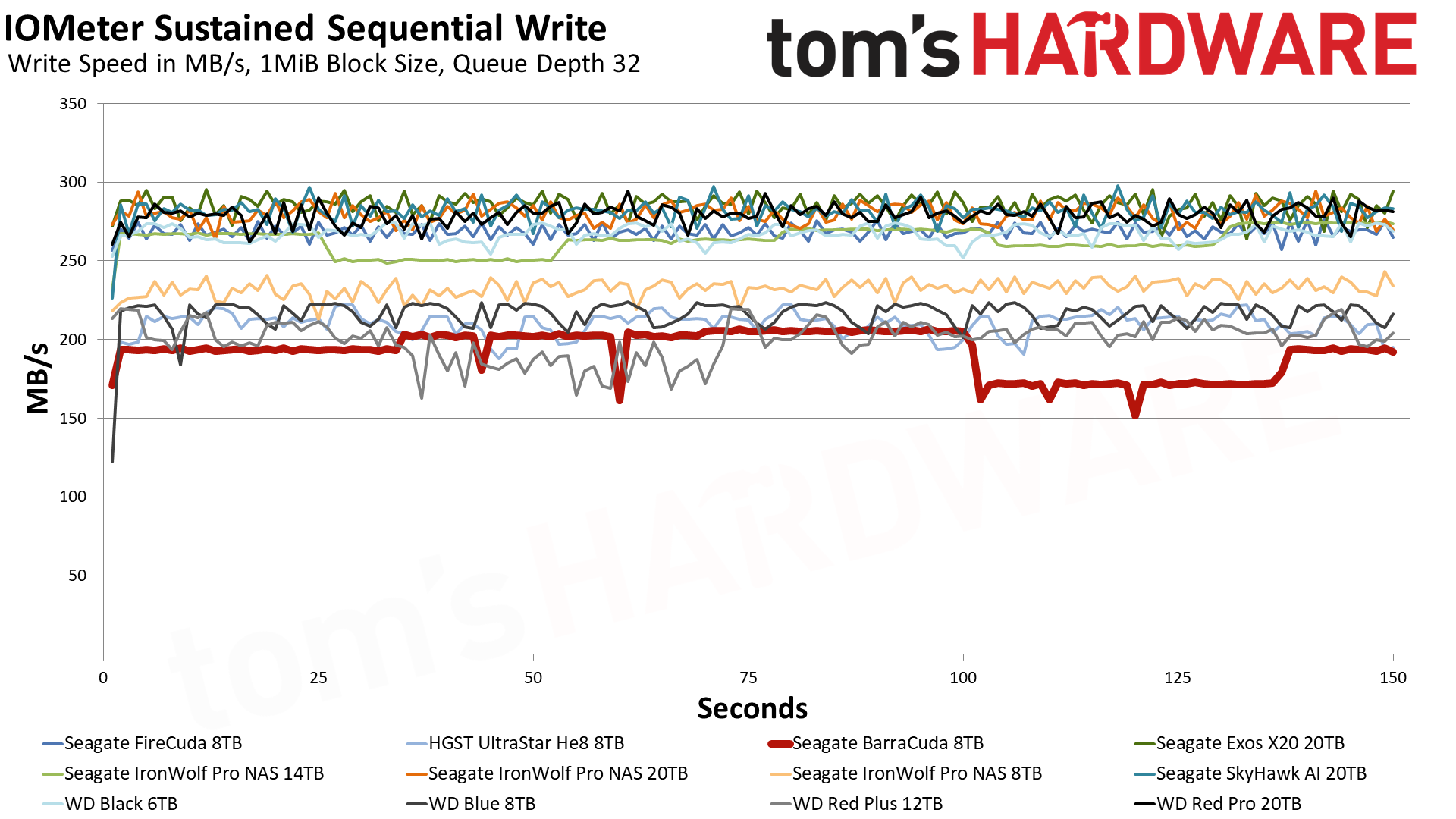
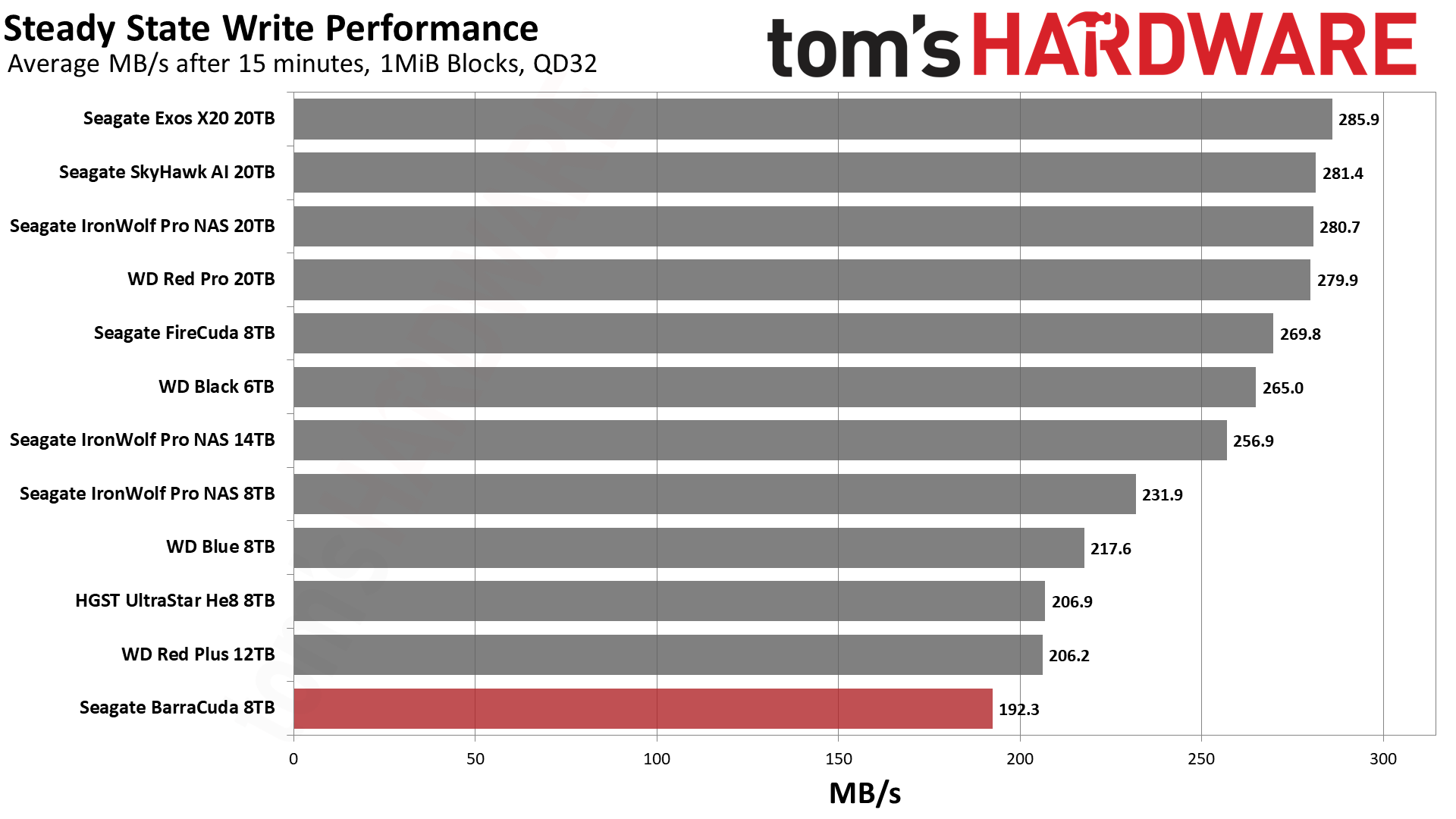
Sustained write performance is adequate, but eventually, there’s a bump in the road. SMR drives can write fine when fresh but eventually will have to rewrite data due to the shingled nature of the storage. This manifests as the interspersed periods of lower performance that you see in the test above, and the impact and duration of this type of performance inconsistency will vary based on the workload. A purely sequential write workload such as the one shown above is the best-case scenario for a write workload on an SMR drive, and you can expect those interspersed periods of lower performance to increase if you mix in smaller files during a transfer. Overall, SMR technology results in slower overall write speeds and poorer write consistency than CMR hard drives.
Power Consumption
We use the Quarch HD Programmable Power Module to gain a deeper understanding of power characteristics. Some drives can consume watts of power at idle while better-suited ones sip just milliwatts. Average workload power consumption and max consumption are two other aspects of power consumption, but performance-per-watt is more important. A drive might consume more power during any given workload, but accomplishing a task faster allows the drive to drop into an idle state more quickly, ultimately saving energy.
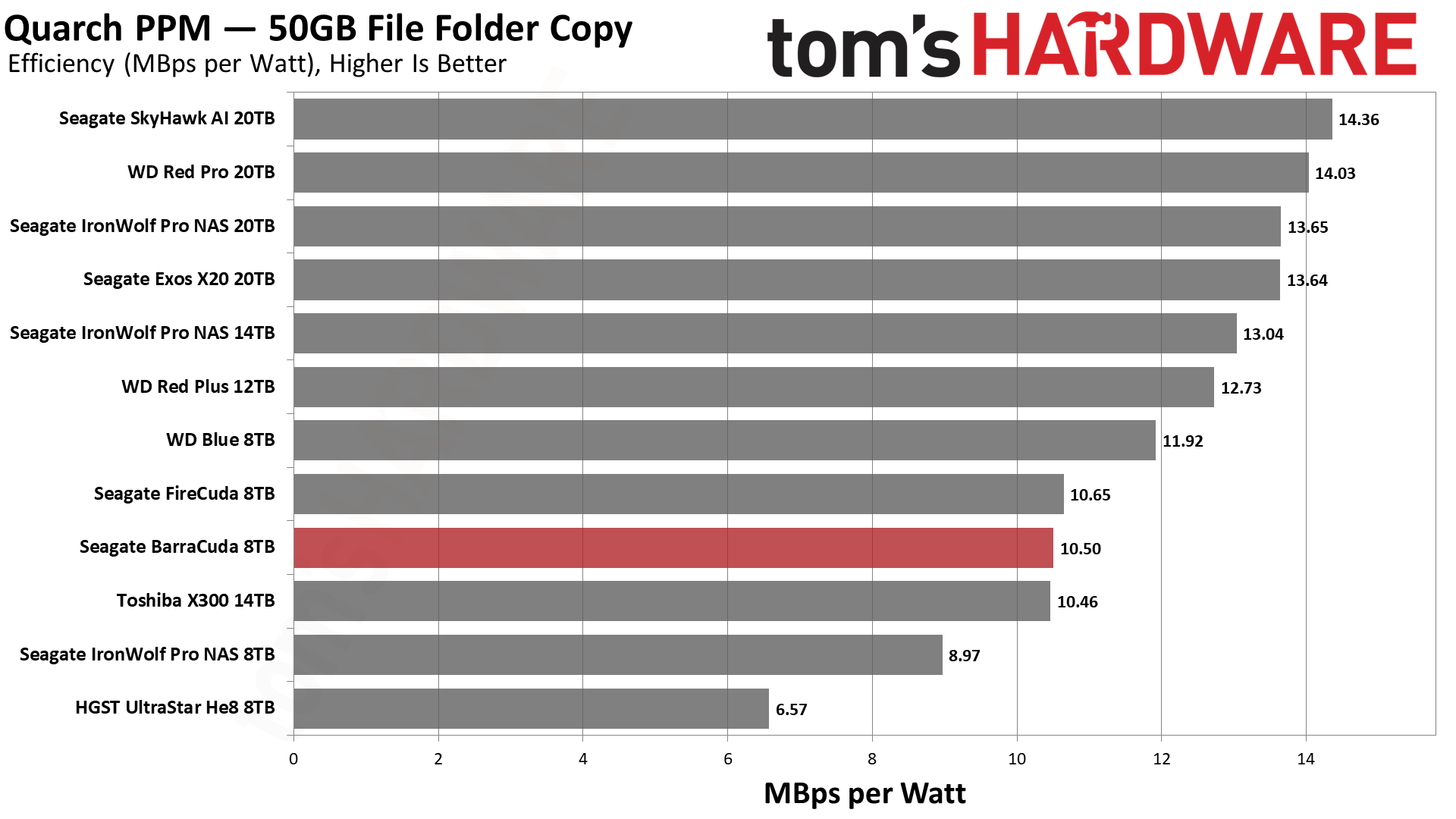
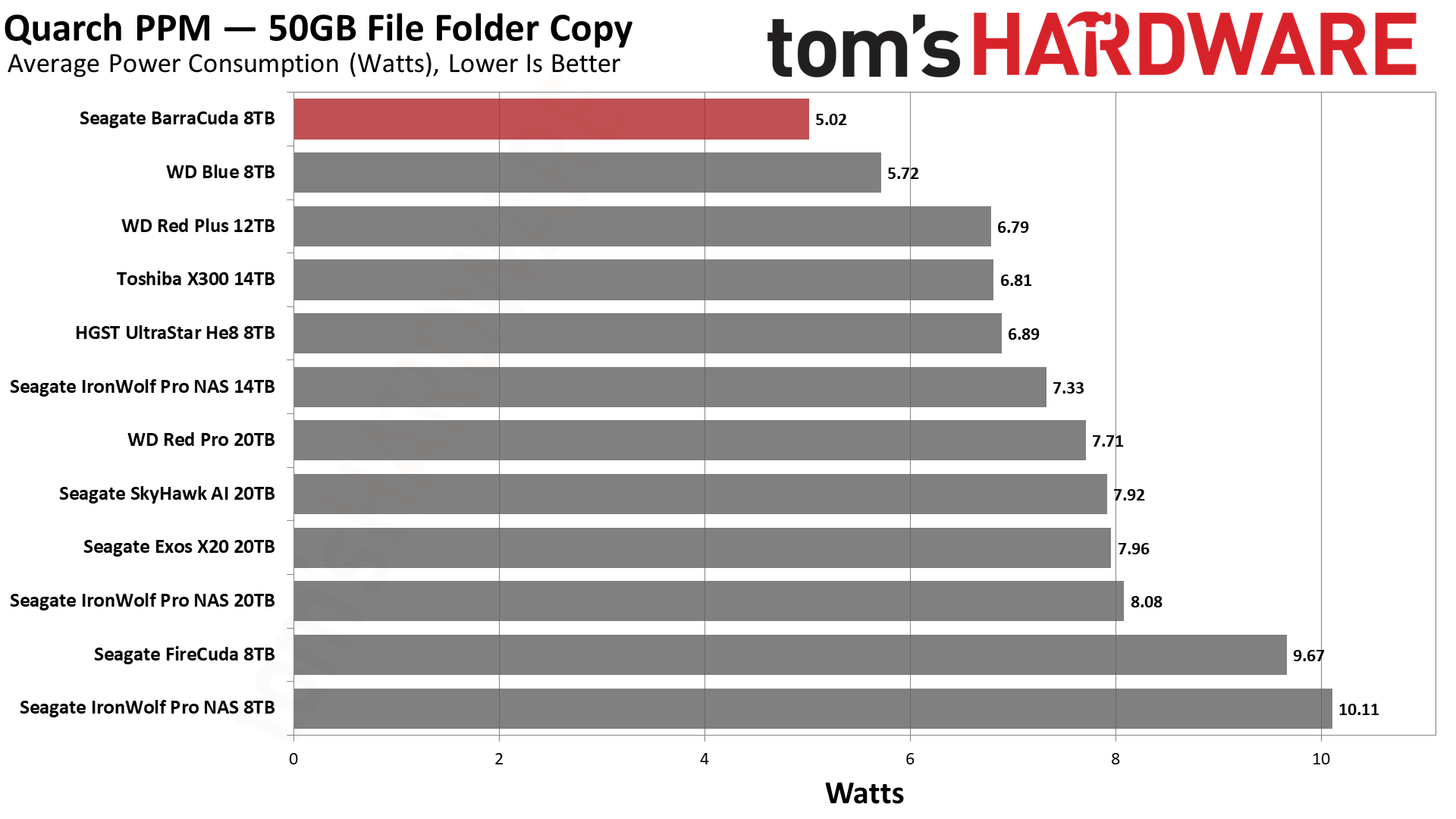
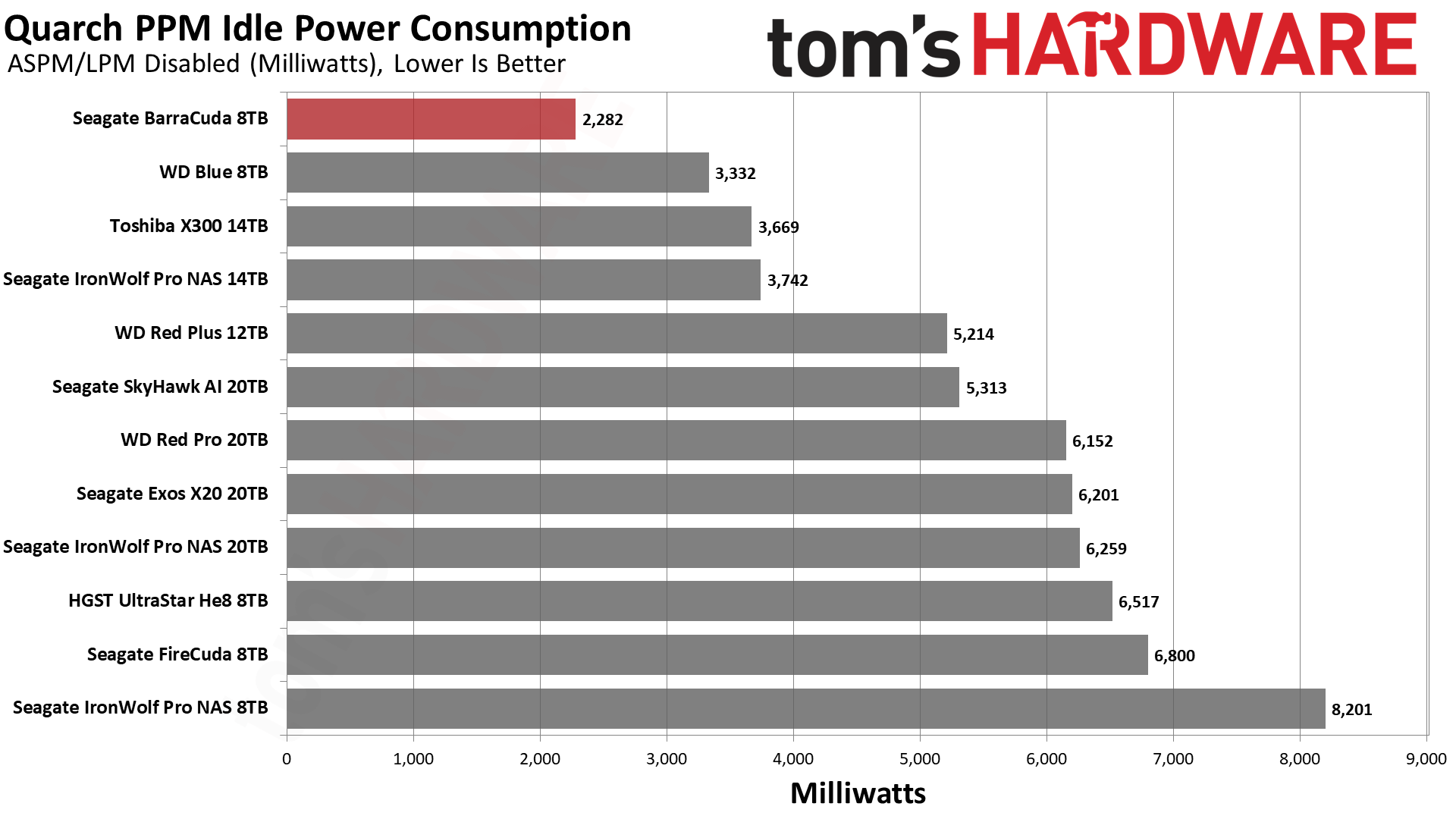
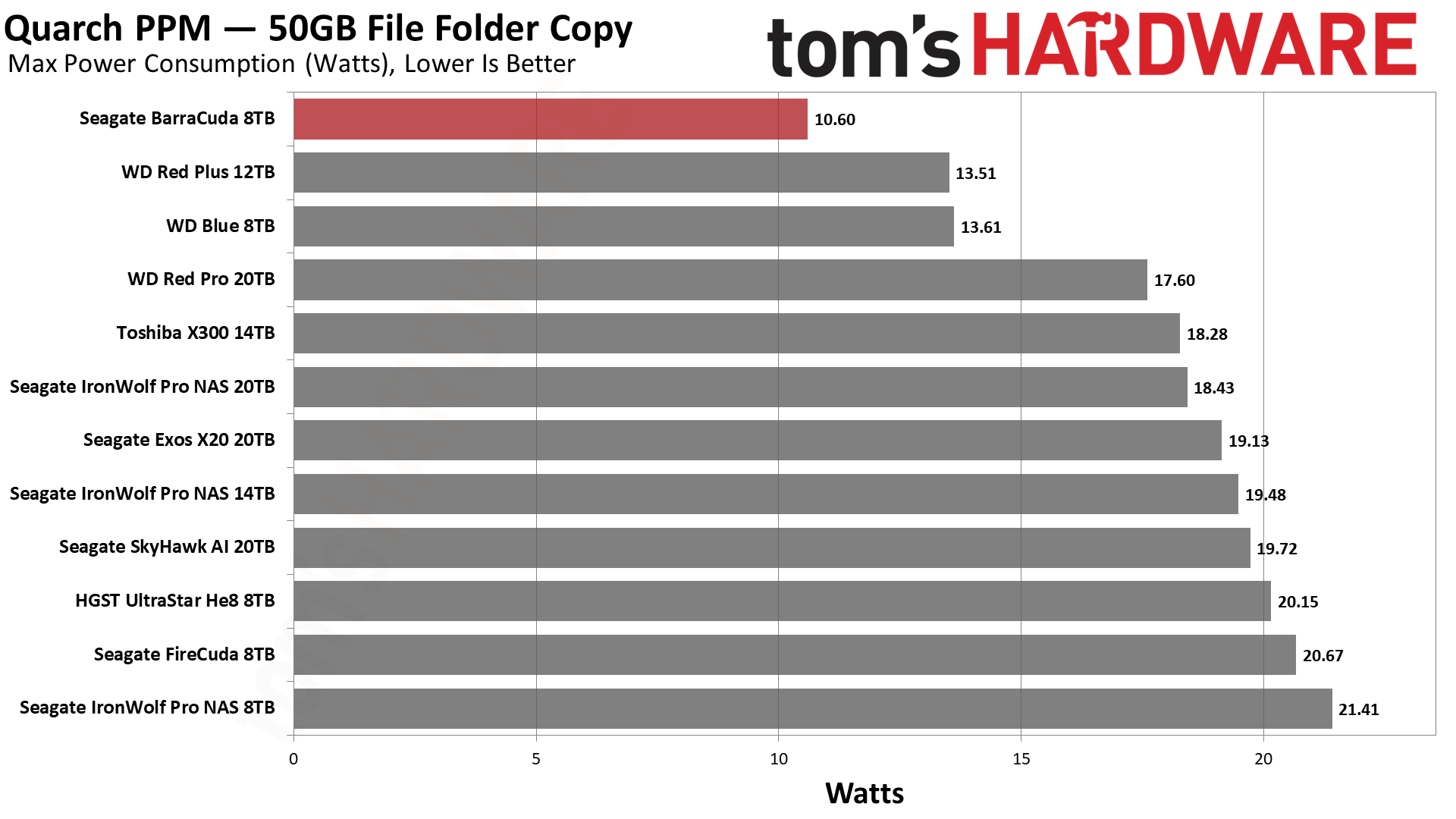
The BarraCuda has very low peak and average power consumption, but it takes longer to finish the workload, so it is not particularly efficient. The FireCuda offers much better performance at the same level, and the X300 offers more capacity at the same level. The WD Blue is also a good competitor for average and peak power consumption while using faster CMR technology.
Test Bench and Testing Notes
| CPU | Intel Core i9-12900K |
| Motherboard | Asus ROG Maximus Z790 Hero |
| Memory | 2x16GB G.Skill DDR5-5600 CL28 |
| Graphics | Intel Iris Xe UHD Graphics 770 |
| CPU Cooling | Enermax Aquafusion 240 |
| Case | Cooler Master TD500 Mesh V2 |
| Power Supply | Cooler Master V850 i Gold |
| OS Storage | Sabrent Rocket 4 Plus 2TB |
| Operating System | Windows 11 Pro |
Conclusion
The Seagate BarraCuda is a typical hard drive that's built and optimized for capacity and lower pricing over performance. As such, it offers plenty of storage space at an inexpensive price point, but it has serious limitations. The product line is limited to 8TB and uses slower SMR technology at every capacity point, restricting the drives' use because write performance and consistency are quite poor, while the competing 8TB WD Blue uses faster CMR tech. The BarraCuda's overall performance is also low. This is partly due to the 5400-RPM spindle speed, but the lower rotational speed is forgivable given the price point.
It’s tempting to spend a little more cash to buy up to Seagate’s 7200-RPM FireCuda, which is better across the board. It has a faster spindle speed that provides better sequential and random performance. The FireCuda also has a much better warranty, including data recovery services. The FireCuda's primary downside is its price-per-TB of storage, so if you're working with a tight budget, the lower-tier 5400-RPM class drives are the way to go.
The BarraCuda seemingly has the edge over the 8TB WD Blue due to its larger cache, but this is needed to help manage the SMR tech and keep the drive from suffering even worse performance. The WD Blue has a small RPM bonus at 8TB that improves performance, but all smaller Blue models operate at 5400-RPM. However, those smaller models match the BarraCuda's 256MB of cache capacity. As you see in our testing, the 8TB WD Blue beats the Seagate BarraCuda in every performance metric due to the combination of its CMR tech and slightly higher 5640-RPM spindle speed.
The BarraCuda also has a workload rate limit (WRL) that defines how much data you can read and write from the drive before reliability degrades, but it’s quite low at 55TB per year during the two-year warranty period. In contrast, the 8TB WD Blue has no workload restriction.
The BarraCuda has to be cheaper than the Blue to be worthwhile, but these drives are often either the same price or within $10 of each other. If the BarraCuda is less expensive, whether the small price savings is worthwhile depends on what you need. If you want an 8TB HDD to store media files, archives, and backups with very infrequent sustained writes, then the SMR technology may not be too detrimental. The Blue is far more compelling for wider general use, particularly with workloads with small files. Neither drive is a good choice if you want top performance or endurance, but the 8TB WD Blue comes out on top for most uses.
MORE: Best SSDs
MORE: Best External SSDs and Hard Drives
MORE: How We Test HDDs And SSDs
MORE: All SSD Content

Shane Downing is a Freelance Reviewer for Tom’s Hardware US, covering consumer storage hardware.
-
Alvar "Miles" Udell ReplyIt’s tempting to spend a little more cash to buy up to Seagate’s 7200-RPM FireCuda, which is better across the board. It has a faster spindle speed that provides better sequential and random performance.
I would disagree and instead look at the IronWolf (non pro), which is $20 less than the Firecuda, and sadly a drive not included in this test. -
Thunder64 ReplyAlvar Miles Udell said:I would disagree and instead look at the IronWolf (non pro), which is $20 less than the Firecuda, and sadly a drive not included in this test.
I wouldn't use a NAS drive in a desktop. They are meant to be used in RAID and may not work well if it takes a few attempts to reread a sector. -
Kamen Rider Blade Honestly, all sales of SMR HDD's to average consumers or through consumer e-tailers or retailors should be banned.Reply
CMR > SMR -
Pyrostemplar I've recently bought one of this drives and while I haven't installed it yet on its final (new) system, I copied a few thousand files (800GB or so of data) to it from an old system.Reply
Purchase reasons are simple: cheapest thing per GB by far (anything else was 30%+ more expensive) and good reviews on Amazon. Note: I'm referring to local prices - US may be quite different.
It performed well enough, with no discernable noise - it seems to be a decent drive for its purposes: occasional archival of files (e.g. fotos, videos) where speed (write and read) is of little concern. For all the rest I have a couple of NVMEs.
Are there better drives on the market? - sure, probably almost all. But - in my case - they were all fairly more expensive (e.g. the 6TB Blue was 30% more expensive than the 8TB Barracuda). -
bikemanI7 I actually Own Seagate 8TB SMR Drive, originally was my main backup drive, til it got so slow i was like forget this. And Purchased a WD My Book 8TB External for my Backup NeedsReply
Though i paid Nothing for my Seagate 8TB SMR Drive as won it in a Twitter Contest during CES 2019
Still use it at times for storage of Music, Pictures, Videos Though
